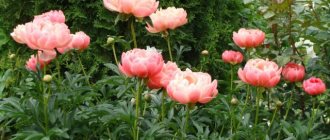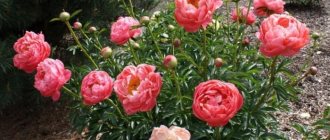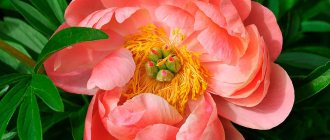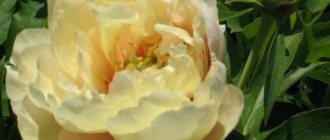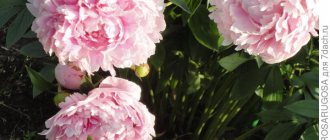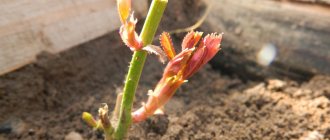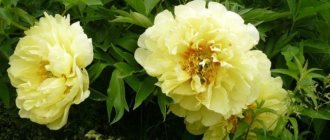Peonies are flowering herbaceous perennials with an ancient history. Today they can be found in almost every garden. Peonies are common throughout the world, but are especially highly valued in China. 2000 years ago, only members of the nobility could grow these flowers. Currently, festivals and exhibitions are organized in the Celestial Empire in honor of this unsurpassed plant. There are more than 5,000 varieties of peonies. One of the most beautiful is the Sarah Bernhardt variety. Peony Sarah Bernhardt is famous for its ease of care and incredibly beautiful delicate flowers of different shades.
Sarah Bernhardt is famous for her beauty and delicate aroma
Description of peony Sarah Bernhardt: photo and description, reviews
This unique variety appeared thanks to the efforts of the French breeder Pierre Louis Lemoine. The gallant Frenchman named his new creation in honor of the outstanding actress Sarah Bernhardt, whose beauty and talent the whole world admired. Wherever this peony is planted, it is always the center of attention, like an actor playing the main role on stage.
The plant is a herbaceous species with high decorative value. Large, beautiful flowers bloom on long, strong stems (about 1 m tall). The bushes look neat and retain their shape perfectly.
The leaves of the Sarah Bernhardt peony are also particularly decorative. Thanks to their openwork shape, they make the bush lush and unusual; with the arrival of cold weather, they do not turn yellow, but acquire an original purple color. The bushes do not require complex care, but they delight with long-lasting and very generous flowering.
Stems reach one meter
Attention! Peony milky-flowering Sarah Bernhardt grows well without support. It may only be required in windy weather.
The plant is light-loving and frost-resistant (up to - 40 ° C). It can grow in regions with different climates: from the central part of Russia to the Urals and Siberia. If the winter is mild, additional insulation is not required. Covering materials are used in severe frosts.
Botanical description
Let's start getting acquainted with the Sarah Bernhardt peony with a description of the variety. He's late ripening
— flowers appear at a time when most varieties have already finished flowering. "Sarah Bernhardt" blooms profusely. The flowers are large, 20 cm in diameter, solitary.
They are supported by long (up to a meter in height) strong stems that are resistant to lodging. Flower petals are semi-double and double
. The main characteristic color of the variety is light pink with a silver border. Today, specimens of white, red, cream, and yellow colors have also been bred. The duration of peony flowering is about a month and a half.
A special feature of this variety is that its leaves do not turn yellow.
, and remain beautiful throughout the summer, turning purple by autumn. They are just like flowers, large, dissected, openwork. Color: dark green. The plant tolerates winter cold well. For its comfort and survival it will only need leaves in the fall.
After this, the division must be placed in a solution (1 tablet / 10 liters of water) for 12 hours. After removal from the solution, the planting material must be thoroughly dried and the sections sprinkled. And only after this you can proceed directly to planting.
Sand should be placed at the bottom of the planting hole. The delenka is deepened into it so much that the distance from the buds to the ground is no more than five centimeters (two or three fingers); a depression that is too deep or too weak may be the reason that the plant.
Planting material is sprinkled with earth and well. In order for the plant to successfully overwinter, it needs a 5-7 cm layer. In the spring, when red shoots appear and rise a little, the mulch can be removed. Since peony bushes tend to spread widely, the distance between planting holes should be at least one meter
.
In late autumn, leaves and stems need to be trimmed, leaving stumps 10-15 cm high. Adult plants do not need it.
How to deal with difficulties
Among the difficulties that can befall peony breeders are diseases and lack of flowering. The main reasons, as a rule, lie in improper care or planting. Let's figure out what these problems may be related to.
The spread of the first disease is facilitated by dense plantings combined with rainy weather. Gray rot
usually attacks young specimens when they enter the active growth phase. It affects leaves, stems and unopened flowers. First, a gray coating forms at the base of the stem. Later it turns a darker color, softens and eventually falls to the ground.
In order to prevent this disease from approaching your peonies, in early spring the bushes and the soil in the tree trunk area need to be treated (3 liters per bush). You can also try using folk remedies - treatment with a solution (one crushed head per 2 liters of water). Spraying should be carried out in the bud phase and two weeks after the first treatment.
A fairly serious disease of peonies is rust.
. You won’t be able to miss its symptoms - these are brown spots on the leaves, which, as a rule, form after flowering. Such leaves will need to be cut and burned. Prevention will consist of the same measures as for gray rot.
Mosaic
is a viral disease that cannot be cured. It appears as light green spots and yellow stripes on the leaves. Infected bushes must be removed and burned.
There may be several reasons why peonies have:
- poorly chosen planting site - the bush will need to be transplanted to an area that matches the preferences of the plant;
- planting too large divisions with a small number of roots, which cannot cope with the task of feeding the shoots. The problem can be solved by new division and replanting;
- frequent transplants and divisions - the plant should be replanted and divided no more often than once every four to five years;
- incorrect fit - too deep or too shallow;
- the bush is quite old - it needs to be divided;
- too acidic soil;
- insufficient application of fertilizers;
- shortage of land;
- gray mold infection or prolonged damp weather;
- insufficient watering;
- damage to the roots or - in the first case, the plant is not subject to further cultivation;
- the plant has contracted a viral disease - it must be uprooted and burned.
Features of flowering
Sarah Bernhardt blooms late, when its fellows are already fading. The bush produces double or semi-double flowers with concave petals. Their main distinguishing feature is their impressive size (up to 20 cm in diameter). Most often there are specimens with soft pink petals edged with a thin silver stripe. White and red specimens were also bred.
You can admire the flowers for more than a month
They look very impressive and, when placed correctly, create an original contrast. You can admire their beauty for 30 to 45 days. The attention of others is immediately attracted to the lush hats of the most delicate shades. If flowering is too abundant, the stems may still need additional support.
Peony varieties Sarah Bernhardt
Having received a unique plant, breeders try to develop several varieties of it. They all have different shades, but together they create a harmonious ensemble, striking in its brightness and beauty.
Peony Sarah Bernhardt Red
The Red Sarah Bernhardt peony rarely grows above 85 cm. The bright petals exude a subtle spicy aroma and look especially unusual against the backdrop of the deep tones of the leaves.
Terry variety with a wide range of shades: from pink to lilac and carmine
Peony Sarah Bernard White
White Sarah Bernhardt peony is used to create wedding arrangements. White petals with a lemon tint seem weightless and airy. Their diameter is only 15 cm, but they are distinguished by a variety of shapes (they can be spherical or resemble a rose) and have a silver border.
White Sarah Bernhardt is great for wedding bouquets
Peony Sarah Bernhardt Unique
The flowers resemble pink pearls that shimmer in the sun. Closer to the edge of the petals the shade becomes noticeably paler. There are also specimens with a purple tint. Peony Sarah Bernhardt Unique (pictured) looks equally impressive both in flower beds and as a cut flower.
Sarah Bernhardt's color is dominated by pastel shades
Peony Sarah Bernhardt Select
Gardeners' opinions about this variety vary: some consider it a separate variety, while others see similarities with Unique. This peony has not yet received wide distribution, so it is too early to talk about its characteristics.
This is Mr. X among the vast family of peonies
Application in design
Sarah Bernhardt peonies go well with many garden plants. It is better to match the “neighbors” in the flowerbed to the color, creating interesting contrasts. But flowers of approximately the same shades will merge into a “spot”. White Sarah Bernhardt peonies are usually combined with irises, sage, poppies, daylilies or bluebells. The deep beauty and mystery of red specimens will be highlighted by a well-groomed, smooth lawn. Pink peonies create complete harmony with thuja and barberry.
Peonies are combined with irises and poppies
Attention! You should not thicken the plantings, because Sarah Bernhardt peonies love free space and require periodic loosening.
The flower will not like the proximity of strongly growing plants. They will take away nutrients from the peony and block natural light.
Low peonies (45-60 cm) are suitable for growing on the balcony. However, the view can feel good on a bright and ventilated balcony if you create the most comfortable conditions for it.
Compatibility of peony with other crops
Before planting, it is recommended to find out what peonies go with and what plants they do not belong next to. Gardeners say that these flowers are in perfect harmony with other plants. They can be used for decoration:
- parks;
- rock gardens;
- landscape massif;
- homestead and garden areas.
Most often, peonies are combined with other crops depending on the shade. The luxury of white varieties is effectively set off by poppies, irises, bluebells, honeysuckle bushes, daylilies and sage. Exquisite, royally chic red flowers are recommended to be planted next to decorative onions. Sarah Bernhardt Pink fits effectively into a composition with barberry bushes or an elegant thuja. You can combine it with hellebores.
Using this variety of peonies, it is easy to create a luxurious garden of continuous flowering. Such a site will smell fragrant and delight the eye with rich shades from spring to autumn. To obtain a similar result, it is recommended to combine peonies with crocuses, irises, daffodils, zinnias, petunias, lilies, godetias, phlox, chrysanthemums or asters.
Reproduction methods
There are three main methods:
- Seeds. They are collected from their own bushes, not fully ripe. Seed material is placed in open ground at the end of summer. At the first stage, they require warmth (from + 18 to + 28 ° C), and then the temperature should gradually decrease (to + 5-10 ° C). Plants may differ in characteristics from their parent specimens.
- By layering. This process is quite troublesome, so only experienced gardeners resort to it. The mother bush requires careful care so that shoots with roots form on it.
- By cuttings. The most effective and simple method. A healthy bush is dug up and cut off at a distance of about 10 cm from the root. Next, the roots are thoroughly washed and completely dried. Then they must be treated with potassium permanganate and kept in a Heteroauxin solution (at least 12 hours). Now you can plant the peony Sarah Bernhardt in the flowerbed.
Propagation by cuttings is the most effective method
Landing rules
The lifespan of Sarah Bernhardt peonies can reach 30 years or more. These plants require an ideal location. The first condition is a sufficient amount of soft diffused light. The second important point is the soil. The herbaceous peony Sarah Bernhardt feels best in slightly acidic soil with a high content of clay and sand.
Loose soil must be flavored with humus. Clay areas are dug up with the addition of sand. But swampy soils are absolutely not suitable.
In conditions of constant humidity, the roots of the plant will quickly die. The area must be cleared of weeds and fertilized.
Peonies should be planted in a well-lit place.
For planting, they usually choose self-harvested seedlings or those purchased from trusted nurseries. The best time is spring, when the thermometer will be stably at + 12 °C.
Sarah Bernhardt's peony planting scheme is very simple:
- Prepare a deep hole in advance so that a powerful root system can freely fit in it.
- Place drainage on the bottom and sprinkle it with organic fertilizer (loam + compost with a small amount of wood ash). Potash should be added to soil that is too acidic.
- The planting material is carefully placed in the hole and all the roots are straightened so that they lie freely in the ground. The buds are buried approximately 5 cm and carefully covered with earth. If the roots are too close or, conversely, far from the surface of the earth, the peony will not bloom.
- At the final stage, the bush is watered and the soil is mulched to conserve moisture.
If you plan to plant several bushes at once, be sure to leave a distance of at least 1 m between them.
Why doesn't it bloom
Errors in care lead to lack of flowering.
Wrong choice of landing site
In a heavily shaded area, you should not expect vigorous flowering. You can correct the situation by transplanting the peony to a small hill, well lit by the sun and blown by the wind.
Frequent transplants and divisions
Replanting a peony more often than five years later leads to a weakening of the plant.
Incorrect landing
A large planting depth is unfavorable due to the roots being too far apart. It is also not recommended to plant a peony at a minimum depth, since the buds will freeze and the flowers will not be able to develop. The optimal depth is 3-4 centimeters.
Respectable age
In bushes that have been growing for several years, the intensity and quality of flowering decreases. Therefore, a transplant or division is required every five years.
Too acidic soil
Soil acidity should be reduced by adding magnesium and calcium. You can use ground limestone, wood ash or crushed chalk.
Potassium deficiency
Lack of potassium also negatively affects the flowering of the Sarah Bernhardt peony. In this situation, you need to feed the plant with a solution of potassium magnesia or potassium sulfate.
Insufficient watering
Dry soil during peony budding leads to a lack of flowering. For proper development, at least 30 liters of water per bush is required.
Diseases or pests
As a result of damage to the peony roots by nematodes or rodents, the bush stops blooming. Affected plants should be destroyed and preventive measures should be used.
Aftercare
Peony Sarah Bernhardt is an unpretentious plant. When setting buds, it is necessary to moisten the soil every 7 days, the rest of the time - less often. You can choose the right watering mode experimentally, taking into account the condition of the soil. Sarah Bernhardt peonies do not like drought or waterlogging. Each bush receives 3 to 4 buckets of water at a time.
Peonies require regular watering and feeding
According to reviews of the Red Sarah Bernard peony and other varieties of the variety, if all planting rules are followed, the first few years of feeding will not be required. Over time, fertilizers are applied only three times throughout the year. In the fall, superphosphate is used, in the summer, a solution based on bird droppings is used, and in the spring, it is enough to carry out the mulching procedure.
You also need to regularly weed the soil around the bushes and promptly remove dried flowers, otherwise they will cause the development of diseases.
Diseases and pests
Peony Sarah Bernhardt, with proper care, is practically not susceptible to diseases and pests, but in some cases it can be disturbed by gray rot, viruses and rodents.
Gray rot
The disease, called gray mold, poses a danger mainly to young and immature plants. Its main symptom is a gray coating on the leaves, flowers and stems.
There are two effective preventive methods:
- Bordeaux mixture - 3 liters for 1 bush;
- garlic solution - 1 chopped head of garlic per 2 liters of water.
Both products are used to treat bushes in early spring.
Rust
Rust is a dangerous disease that leads to disruption of the metabolic process, as well as a decrease in the immunity and winter hardiness of the plant. The causative agent is a rust fungus. It is easy to determine the infection - spots of a characteristic brown color appear on the peony leaves. To get rid of the disease, you need to cut off and burn all affected areas of the bush.
Mosaic
Mosaic, or ring mosaic, is a viral disease that manifests itself in the form of yellow and light green spots and stripes localized on the surface of the leaves. It cannot be treated. In order to prevent further spread of infection, it is necessary to uproot and burn the bush.
See also
Characteristics and description of Kansas peony, planting and care rulesRead
Nematodes
Nematodes are small roundworms that attack leaves, flowers, stems and even roots of a plant. The main symptoms of pest activity are:
- curvature of stems;
- swelling on the rhizomes;
- yellowish tint of leaves.
It is difficult to fight nematodes, since an abundance of chemicals is undesirable for a garden plot. The infected plant must be completely dug up and burned.
As a preventative measure, before planting a peony, you should carefully inspect the roots, and clean garden tools of any remaining soil and douse them with boiling water.
Rodents
Mice and other rodents are also enemies of peonies. They spoil the roots of plants, as a result of which the leaves begin to curl.
For protection purposes, it is advisable to plant several plants next to peonies that have a repellent effect on rodents. These include:
- black elderberry;
- chamomile;
- tansy;
- perithrum maiden;
- wormwood.
